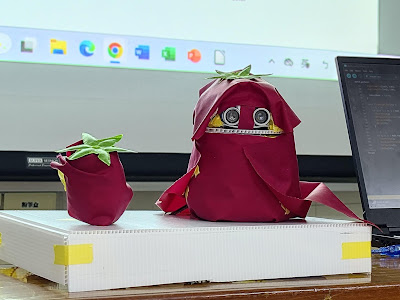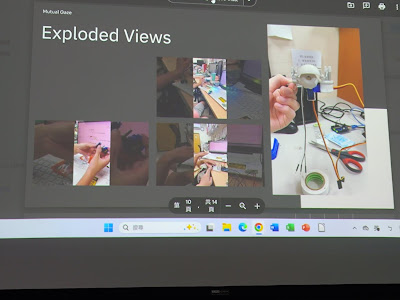2025年6月9日 星期一
2025年5月23日 星期五
week 15. final project discussion
sFinal Project: (deadline: 6/3, 2025)
2025年5月17日 星期六
week 14. project proposal
方法:
annotated portfolios (註記作品集)
設計考量:
1. 動作分析 (LMA 拉邦動作分析) 與 動作設計
2. 知覺現象學模型
3. 體現譬喻 (embodied metaphor)
4. 身體基模與身體意象(body schema & body image)
概念設計:
身體動作與燈光變化互動設計 - 使用情境設定 (居家、遊戲、展場、咖啡店、車站...)
身體與空間的關係,燈光反應與身體的關係
實作:
arduino + 感測器 + 燈條 實現可以展示的部分
2025年5月11日 星期日
week 13. 知覺現象學
1.
分組報告相關作品之註記作品集、意象看板(搜尋 Pinterest, 或 CIID interaction design),初步構想,草圖,動作等等。
2.
Perceptual crossing:
1. Designing for perceptual crossing to improve user involvement
2. Designing for Perceptual Crossing: Applying and Evaluating Design Notions
3. Designing for perceptual crossing: designing and comparing three behaviors
Extra experiment:
“It's So Touching”: Emotional Value in Distal Contact
2025年5月4日 星期日
week 12. embodied metaphor & body schema
0. students share hardware sketches
Embodied metaphors in tangible interaction design (https://www.researchgate.net/publication/225745928_Embodied_metaphors_in_tangible_interaction_design)
1. what is embodied metaphor?
2. what is body schema (身體基模)? what is body image (身體圖像)?
3. what is phenomenology of perception?
4. what is perceptual crossing? (http://www.ijdesign.org/index.php/IJDesign/article/view/1062/537)
2025年4月20日 星期日
week 10. annotated portfolios
1. Bill Gaver, Annotated Portfolios
1. LMA
Designing Behavior in Interaction: Using Aesthetic Experience as a Mechanism for Design
2. Dan Saffer: Free form movement patterns
Embodied metaphors in tangible interaction design
2025年3月30日 星期日
week 7. arduino hack and hardware sketching
Review "metaphor in Interaction Design"
Sketching in Hardware and Building Interaction Design: tools, toolkits and an attitude for Interaction Designers
Reference:
EX4: (2025/5/8)
Sketching in Hardware and Material
1. using arduino, sensors, actuators and other materials (ex., paper, wood, clothe, ...) to perform sketching
2. sketching can be no purpose, no function, no user
3. Take photos, or videos, upload to google drives
4. criteria (評分標準):
evocative
suggest
question
explore
provoke
...
2025年3月22日 星期六
week 6. metaphor
MusicBottles by Tangible Media Group
I/O Brush by Tangible Media Group
Tech Tap by PEGA design
Just Draw It by PEGA Design
2025年3月16日 星期日
week 5. form review
2. feature interaction designer: Dan Saffer
MeCaMInD (Movement-based Cards for Interaction Design)
(https://mecamind.eu/documents/Cards_MovementMethods.pdf)Shake to change:
Kyary Pamyu Pamyu ♪ Ninjya Re Bang Bang ☆ au CM Making!
Reference:
Designing Gestural Interfaces by Dan Saffer
2025年3月8日 星期六
week 4. form practice and gestural interaction
Digital Photo Printer re-design from Jasper Dekker on Vimeo.
SWYP: See What You Print from Artefact on Vimeo.
https://www.artefactgroup.com/work/swyp/
http://www.ludwigrensch.com/paper-a-printer-you-actually-want
Re-designing printers:
Berg Little Printer
Paperang Portable thermal printer
Reflexive printer from Benforest on Vimeo.
Dispensing with words
Foam Core
MeCaMInD (Movement-based Cards for Interaction Design)
(https://mecamind.eu/documents/Cards_MovementMethods.pdf)2025年3月2日 星期日
week 3. form making
(original paper in IJDesign by Rung-Tai Lin)
2.
3.

persuasive design
4. A hierarchy of consumer needs by P. Jordan:
(image from http://www.sciencedirect.com/science/article/pii/S1369702103012239)
5. Timo Arnall: A form vocabulary for RFID
(nearfield.org)
6.
"Forms in various materials invite touch and manipulation"
Retrieved from interactions
7.
siteless book sample page
8.

Retrieved from "Move to get moved"
9.
tapTap from Andy Huntington on Vimeo.
Algo.Rhythm from Huaishu on Vimeo.
Algo.Rhythm: computational thinking through tangible music device
1. How to design simple forms for rich interaction? (including movement-centric, social interaction, self-expression, etc.)
2. What's the relationship between movement and form? Can we think "movement" without form?
3. What kind of form is suitable for movement?

4. Echoing "tangible interaction = form + computing" by Mark Baskinger and Mark Gross, if "tangibility = movement + form", how can Tangibility be explored?
5. Affordance: restriction or hint?
Practice:
regarding "functionality" of a music player, pick up 8 representative forms on the above siteless sample page for 8 Effort qualities of LMA. Draw 8 sketches based on the above forms and corresponding movements.

Retrieved from "Move to get moved"
Retrieved from "interactions"
EX3:
make a physical model of a music player
(reference: http://ciid.dk/education/portfolio/idp12/courses/tangible-user-interface/projects/)
show the picture of this model, and analyze according to LMA and gesture patterns (proximity to activate/deactivate, point to activate, rotate to change state, shake to change state...)
perform the movement on the music player with Wizard of Oz method (Bluetooth speakers needed)
Reference: Chapter 4 in Designing Gestural Interfaces (check e-book in library.ntust.edu.tw)
(reference: http://www.trendhunter.com/slideshow/ipod-alternatives)
https://www.slideshare.net/jazzliang/tangible-interaction-2011-spring





































